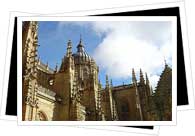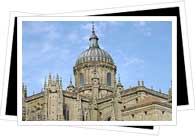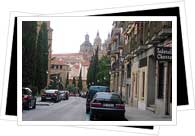Salamanca: Early History  Salamanca got its early start around 400 B.C, when indiginous Celtic tribes, known as the Vacceos, first fortified the area to protect their territories along the Duero River. Not even 150 years down the line, Hannibal and his Carthaginian forces beseiged the area and settled in until the Roman Empire extended into the area and quickly overtook it. During its incorporation into the Roman province of Lusitania, Salamanca- then called Salmantica or Helmantica- became a staging post on the Vía Lata (Silver Route) and enjoyed its first taste as an important hub of commerical activity.
Salamanca got its early start around 400 B.C, when indiginous Celtic tribes, known as the Vacceos, first fortified the area to protect their territories along the Duero River. Not even 150 years down the line, Hannibal and his Carthaginian forces beseiged the area and settled in until the Roman Empire extended into the area and quickly overtook it. During its incorporation into the Roman province of Lusitania, Salamanca- then called Salmantica or Helmantica- became a staging post on the Vía Lata (Silver Route) and enjoyed its first taste as an important hub of commerical activity.
Christianity made its first appearance in Salamanca with the decline of the Roman Empire and the arrival of the Visigoths sometime before 600 A.D. However, the massive Muslim invasion of Spain in the eighth century put a quick halt Visigoth power. The Muslim empired enjoyed a period of rule in Salamanca and its surroundings, but soon Salamanca again piqued the interest of Christian powers who proceeded to win, lose, and recuperate the city over and over again.
Salamanca History: 11th-14th Centuries This ping-pong game of power finally came to an end with the Spanish monarch Alfonso VI, who drove the Muslim powers down into the south- where Muslim strongholds would maintain power well into the 15th century. Shortly following this victory, Salamanca was granted its first municipal at the end of the 11th century and then incorporated as part of Castilla during the early part of the 12th century. This paved the way for the re-population of what would soon become the Salamanca province to begin.
This ping-pong game of power finally came to an end with the Spanish monarch Alfonso VI, who drove the Muslim powers down into the south- where Muslim strongholds would maintain power well into the 15th century. Shortly following this victory, Salamanca was granted its first municipal at the end of the 11th century and then incorporated as part of Castilla during the early part of the 12th century. This paved the way for the re-population of what would soon become the Salamanca province to begin.
The 13th century saw one of the biggest turning points in the history of Salamanca with the founding of the university by another royal Alfonso- this time Alfonso IX. Just a few years down the road, Pope Alexander IV was already declaring the university to be one of the "four leading lights" of the world. Rubbing shoulders with the established academic centers of Paris, Bologna and Oxford, the illustrious reputation of the university led not only to the further flourishing of its academic side but also of the city itself- today you can still visit historical buildings attributed to this epoch of growing affluency.
Salamanca History: 15th-16th Centuries  The university's importance continued well into the 16th century, providing the city with academic, cultural and economic wealth. Due in part to the generous patronage of Queen Isabel, the famed Catholic monarch, Salamanca was the focal point of some of Spain's richest cultural activity during the 15th century- the city's Gothic and Renaissance architecture serve as vestiges from this prosperous era.
The university's importance continued well into the 16th century, providing the city with academic, cultural and economic wealth. Due in part to the generous patronage of Queen Isabel, the famed Catholic monarch, Salamanca was the focal point of some of Spain's richest cultural activity during the 15th century- the city's Gothic and Renaissance architecture serve as vestiges from this prosperous era.
This epoch also saw a rise in political and social turmoil. Along with political issues which divided and bloodied the city, Salamanca had become an important post for Christian theology in Spain as part of the counter reformation- a movement which essentially tried to reel people back to Catholicism during an epoch in which Protestantism was on the rise in much of Europe. Naturally, this made Salamanca a hot-spot of the brutal, merciless witch-hunt known as the Spanish Inquisition. You may be surprised to know that the graceful Plaza Mayor, now filled with terrace cafés and strolling couples, was once host to massive book-burnings and brutal executions of alleged heretics.
Salamanca History: 17th-19th Centuries
During the 17th century, Salamanca followed the rest of the surrounding Castilla into decline, which due to a series of wars, epidemics and economic crises would last well into the 19th century. The War of Spanish Succession following the death of the heirless king Carlos II overtook and divided the country for its 13-year duration. However, when Felipe V eventually emerged as the victor he ordered the construction of Salamanca's Plaza Mayor, one of the city's most revered assets, to thank the city for its unwavering support.
The next war, while much shorter managed to affect Salamanca in a much more marked way. As Napoleon ambitiously sought to make all of Europe his, Spain fought back. With the hegemony of Europe on the line, the Independence War (1808-1811) eventually made its way to the gates of Salamanca with the decisive Battle of Arapiles- also known as the Battle fo Salamanca. Lord Wellington led the Spanish troops to a victory over Napoleon's troops, which was the first major turning point towards Napoleon's withdrawal from Spain. While many of Salamanca's buildings were left in various states of ruin and the university naturally hit a low point, French forces were at least out of the picture allowing for recovery and rebuilding.
Salamanca: Modern History
By 1900 the city had recovered, albeit faster than the university. However, at this time Miguel de Unamuno, one of the most influential writers and thinkers in Spain's history, was Vice Chancillor of the University- a sign of its slow but steady recovery. The university and the city continued to restore themselves to their former glory, but the recovery truly launched into bloom with the restoration of democracy following dictator Francisco Franco's death after decades of oppressive rule.
Between 1975 and today, Salamanca has reformed both socially and politically into a modern city that continues to bask in the spirit of its illustrious history. In recent years, Salamanca was named not only a UNESCO heritage city but also garnered the title of European Capital of Culture in 2002. Come visit to see why!